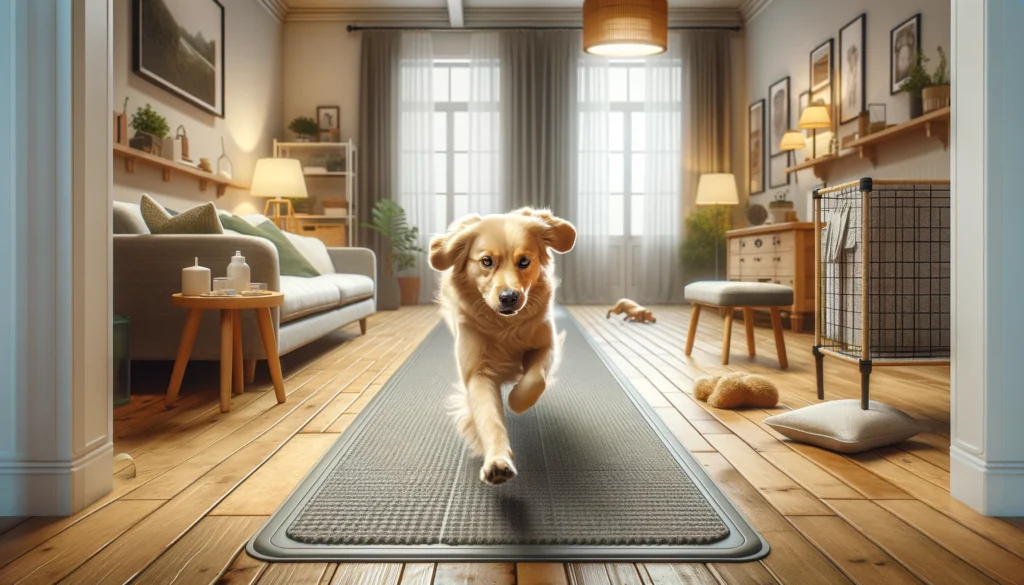“Zoomies” — those sudden, frantic bursts of energy — are hilarious and totally normal. But when your dog starts sprinting across the living room, bouncing off furniture, or knocking over decor, it can feel overwhelming, especially when outdoor access isn’t an option.
Luckily, there are smart and safe ways to help your dog release that energy indoors without chaos. Here’s how to handle and even enjoy zoomies in your home environment.
What Are Zoomies, Exactly?
The technical term is Frenetic Random Activity Periods (FRAPs). Zoomies usually involve:
- Rapid sprints in circles or laps
- Play bows and wild eye contact
- Sudden stops and changes in direction
- Random leaping or furniture ricocheting
They’re most common after naps, baths, or being confined — and they’re completely natural, especially in puppies and high-energy breeds.
Why Dogs Get Zoomies
Zoomies are often triggered by:
- Pent-up energy from too much rest or boredom
- Excitement from seeing a favorite person or toy
- Stress relief after anxiety or restraint (like crate time)
- Daily rhythms, especially at dusk (the “witching hour”)
They’re healthy, as long as they’re safe. Your job isn’t to stop zoomies — it’s to manage them.
Tip 1: Create a Safe “Zoomie Zone”
Clear space makes all the difference.
- Move low tables, breakables, or sharp objects from the area
- Use non-slip rugs or foam mats to protect joints and prevent sliding
- Choose a long hallway or open living room for high-speed dashes
Let your dog know this is their play zone. If you can’t rearrange, close off unsafe rooms instead.
Tip 2: Schedule Intentional Energy Burn Sessions
Zoomies are often the result of unspent energy.
- Plan indoor play twice a day (morning and late afternoon)
- Use toys that encourage movement like tug ropes or fetch balls
- Try hide-and-seek games or stair climbs if available
By directing their energy, you reduce the chance of random outbursts.
Tip 3: Use Tug as a Safe Zoomie Alternative
Tug is intense and satisfying — a great replacement for hallway sprints.
- Use a strong, soft rope toy or tug ring
- Let your dog “win” to build confidence
- Keep sessions short (5–10 minutes)
It tires them out without needing much space.
Tip 4: Add Mental Stimulation Before Peak Energy Times
Mental work can be just as exhausting as physical activity.
- Feed meals in puzzle toys or treat-dispensing balls
- Practice training commands like sit, stay, or spin
- Rotate toys every few days to avoid boredom
Tired minds equal calmer dogs — even in small spaces.
Tip 5: Let Zoomies Happen (Safely)
You don’t always need to intervene.
- If your dog is safe and not damaging anything, let them run
- Laugh, observe, and let them “burn it out”
- Have a soft blanket or bed nearby for the cooldown
Zoomies usually last only a few minutes — no need to panic.
Tip 6: Redirect With Positive Play
If the zoomie moment gets too wild:
- Grab a favorite toy and redirect energy toward structured play
- Ask for a “sit” or “touch” to reset their brain
- Toss a ball down the hall to give them a focused outlet
Always reward calm behavior after the rush ends.
Tip 7: Use Calming Cues and Routine
Predictability reduces overstimulation.
- Keep mealtimes, naps, and play sessions on a consistent schedule
- Use verbal cues like “settle” or “break” during play
- Dim the lights or play soft music as the day winds down
Routine helps your dog regulate energy more effectively.
Tip 8: Know When It’s Not Zoomies
Zoomies are fun — but some behaviors might look similar while signaling something else.
- Constant pacing with whining may indicate anxiety
- Circling with obsessive focus could be a neurological issue
- Destructive bursts (like shredding furniture) may mean frustration
If something feels off, consult a vet or behaviorist.
Zoomies Are Normal — and Manageable
Zoomies indoors don’t have to wreck your peace (or your living room). By creating safe outlets, adding structure, and engaging your dog’s brain, you can turn these energetic bursts into a joyful part of daily life.
In the end, zoomies aren’t a problem — they’re proof your dog is healthy, happy, and very much alive.






